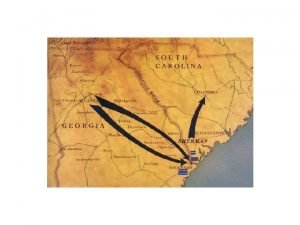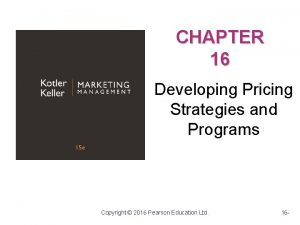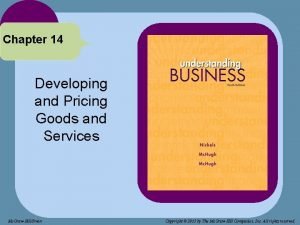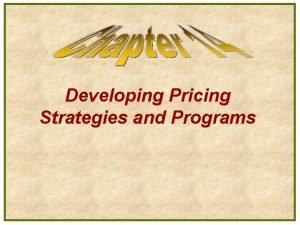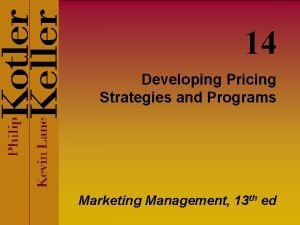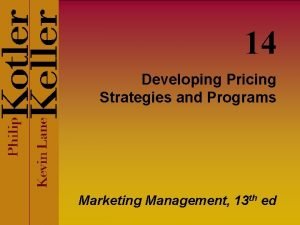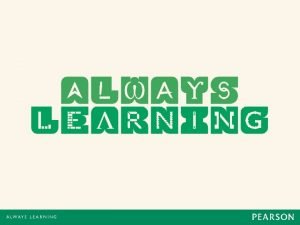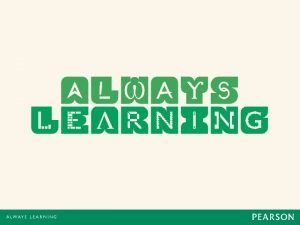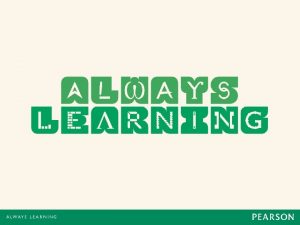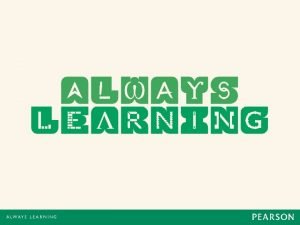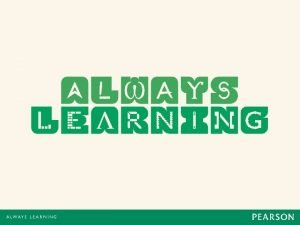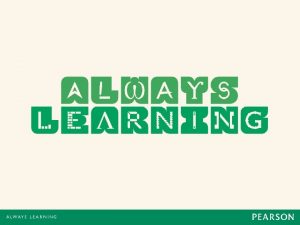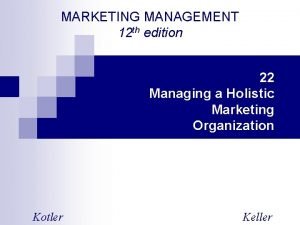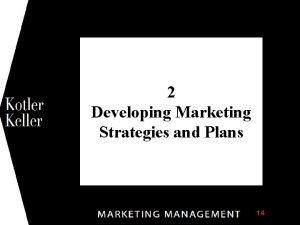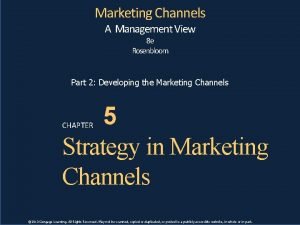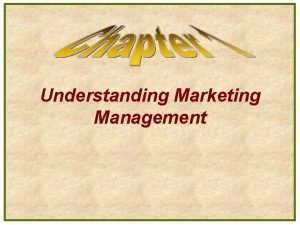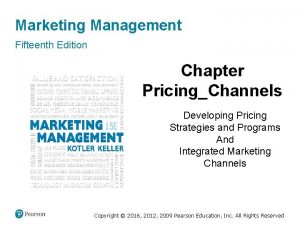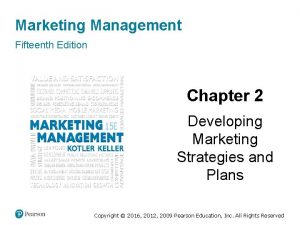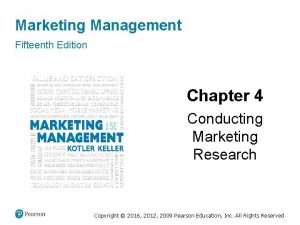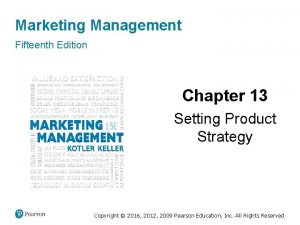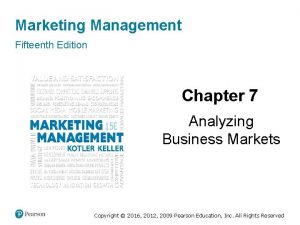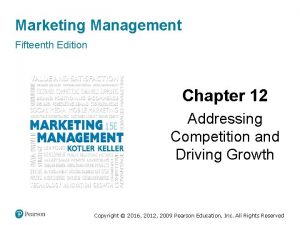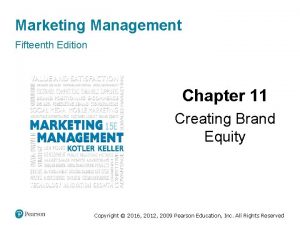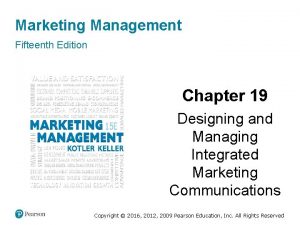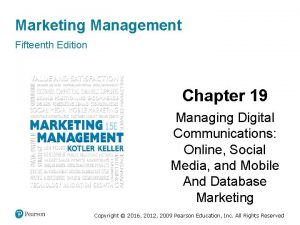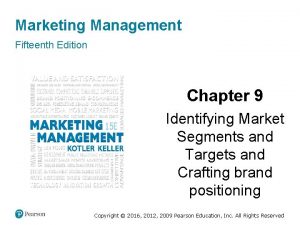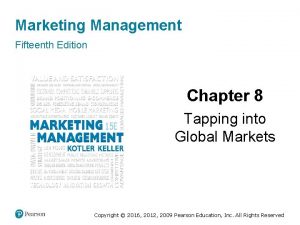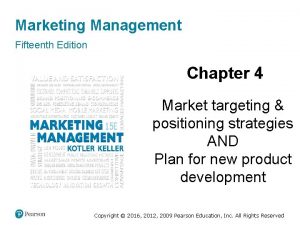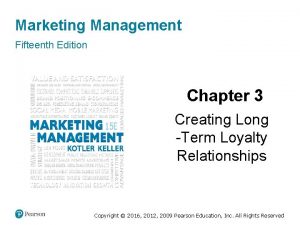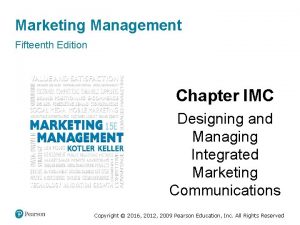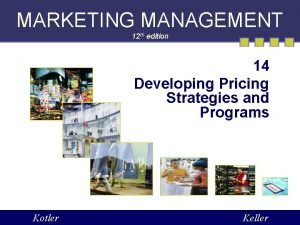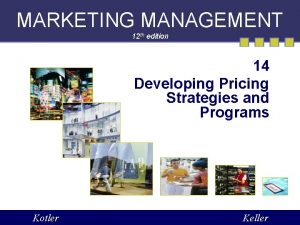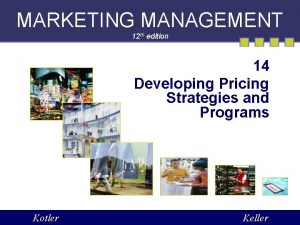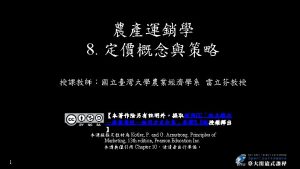Marketing Management Fifteenth Edition Topic 6 Developing pricing






































- Slides: 38

Marketing Management Fifteenth Edition Topic 6 Developing pricing strategies and programs (From Kotler CH 16) AND Managing Retailing (From Kotler CH 22) Copyright © 2016, 2012, 2009 Pearson Education, Inc. All Rights Reserved

Understanding Pricing (3 of 3) • How companies price – Small companies: boss – Large companies: division/product line managers • How companies should price – Understanding of consumer pricing psychology – a systematic approach to setting, adapting, and changing prices Copyright © 2016, 2012, 2009 Pearson Education, Inc. All Rights Reserved

Setting the Price Table 16. 2 Steps in Setting a Pricing Policy 1. Selecting the Pricing Objective 2. Determining Demand 3. Estimating Costs 4. Analyzing Competitors’ Costs, Prices, and Offers 5. Selecting a Pricing Method 6. Selecting the Final Price Copyright © 2016, 2012, 2009 Pearson Education, Inc. All Rights Reserved

Step 1: Selecting the Pricing Objective • Survival • Maximum current profit • Maximum market share • Product-quality leadership • Maximum market skimming Copyright © 2016, 2012, 2009 Pearson Education, Inc. All Rights Reserved

Step 2: Determining Demand • Price sensitivity • Estimating demand curves – Surveys, price experiments, & statistical analysis • Price elasticity of demand Copyright © 2016, 2012, 2009 Pearson Education, Inc. All Rights Reserved

Figure 16. 1 Inelastic And Elastic Demand Copyright © 2016, 2012, 2009 Pearson Education, Inc. All Rights Reserved

Price Sensitivity Table 16. 3 Factors That Reduce Price Sensitivity • The product is more distinctive. • Buyers are less aware of substitutes. • Buyers cannot easily compare the quality of substitutes. • The expenditure is a smaller part of the buyer’s total income. • The expenditure is small compared to the total cost of the end product. • Part of the cost is borne by another party. • The product is used in conjunction with assets previously bought. • The product is assumed to have more quality, prestige, or exclusiveness. • Buyers cannot store the product. Copyright © 2016, 2012, 2009 Pearson Education, Inc. All Rights Reserved

Step 3: Estimating Costs (1 of 3) • Types of costs and levels of production – Fixed vs. variable costs – Total costs – Average cost Figure 16. 2 Cost per Unit at Different Levels of Production per Period Copyright © 2016, 2012, 2009 Pearson Education, Inc. All Rights Reserved

Step 3: Estimating Costs (2 of 3) • Accumulated production – Experience/learning curve Figure 16. 3 Cost per Unit as a Function of Accumulated Production: The Experience Curve Copyright © 2016, 2012, 2009 Pearson Education, Inc. All Rights Reserved

Step 3: Estimating Costs (3 of 3) • Target costing – Price less desired profit margin Copyright © 2016, 2012, 2009 Pearson Education, Inc. All Rights Reserved

Step 4: Analyzing Competitors’ Prices • Firm must take competitors’ costs, prices, & reactions into account – Value-priced competitors Copyright © 2016, 2012, 2009 Pearson Education, Inc. All Rights Reserved

Step 5: Selecting a Pricing Method (1 of 6) • Three major considerations in price – Costs = price floor – Competitors’ prices = orienting point – Customers’ assessment of unique features = price ceiling Figure 16. 4 The Three Cs Model for Price Setting Copyright © 2016, 2012, 2009 Pearson Education, Inc. All Rights Reserved

Step 5: Selecting a Pricing Method (2 of 6) • Markup pricing – Add a standard markup to the product’s cost Copyright © 2016, 2012, 2009 Pearson Education, Inc. All Rights Reserved

Step 5: Selecting a Pricing Method (3 of 6) • Target-return pricing – Price that yields its target rate of return on investment Copyright © 2016, 2012, 2009 Pearson Education, Inc. All Rights Reserved

Figure 16. 5 Break-Even for Target-Return Price Copyright © 2016, 2012, 2009 Pearson Education, Inc. All Rights Reserved

Step 5: Selecting a Pricing Method (4 of 6) • Perceived-value pricing – Based on buyer’s image of product, channel deliverables, warranty quality, customer support, and softer attributes (e. g. , reputation) Copyright © 2016, 2012, 2009 Pearson Education, Inc. All Rights Reserved

Step 5: Selecting a Pricing Method (5 of 6) • Value pricing • EDLP – High-low pricing • Going-rate pricing Copyright © 2016, 2012, 2009 Pearson Education, Inc. All Rights Reserved

Step 5: Selecting a Pricing Method (6 of 6) • Auction-type pricing – English (ascending) – Dutch (descending) – Sealed-bid Copyright © 2016, 2012, 2009 Pearson Education, Inc. All Rights Reserved

Step 6: Selecting the Final Price • Additional factors to select final price: ‒ ‒ Impact of other marketing activities Company pricing policies Gain-and-risk-sharing pricing Impact of price on other parties Copyright © 2016, 2012, 2009 Pearson Education, Inc. All Rights Reserved

Adapting the Price (1 of 5) • Geographical pricing – – Barter Compensation deal Buyback arrangement Offset Copyright © 2016, 2012, 2009 Pearson Education, Inc. All Rights Reserved

Adapting the Price (2 of 5) • Price discounts and allowances Table 16. 4 Price Discounts and Allowances Discount: A price reduction to buyers who pay bills promptly. A typical example is “ 2/10, net 30, ” which means payment is due within 30 days and the buyer can deduct 2 percent by paying within 10 days. Quantity Discount: A price reduction to those who buy large volumes. A typical example is “$10 per unit for fewer than 100 units; $9 per unit for 100 or more units. ” Quantity discounts must be offered equally to all customers and must not exceed the cost savings to the seller. They can be offered on each order placed or on the number of units ordered over a given period. Functional Discount: Discount (also called trade discount ) offered by a manufacturer to trade-channel Members if they perform certain functions, such as selling, storing, and record keeping. Manufacturers must offer the same functional discounts within each channel. Seasonal Discount: A price reduction to those who buy merchandise or services out of season. Hotels, motels, and airlines offer seasonal discounts in slow selling periods. Allowance: An extra payment designed to gain reseller participation in special programs. Trade-in allowances are granted for turning in an old item when buying a new one. Promotional allowances reward dealers for participating in advertising and sales support programs. Copyright © 2016, 2012, 2009 Pearson Education, Inc. All Rights Reserved

Adapting the Price (3 of 5) • Loss-leader pricing • Low-interest financing • Special event pricing • Longer payment terms • Special customer pricing • Warranties/service contracts • Cash rebates • Psychological discounting Copyright © 2016, 2012, 2009 Pearson Education, Inc. All Rights Reserved

Adapting the Price (4 of 5) • Price discrimination – – – Customer-segment pricing Product-form pricing Time pricing Image pricing Location pricing Channel pricing Copyright © 2016, 2012, 2009 Pearson Education, Inc. All Rights Reserved

Retailing • Retailing – All the activities in selling goods or services directly to final consumers for personal, nonbusiness use • Retailer/retail store – Any business enterprise whose sales volume comes primarily from retailing Copyright © 2016, 2012, 2009 Pearson Education, Inc. All Rights Reserved

Types of Retailers (1 of 5) • Store retailers, nonstore retailers, and retail organizations Copyright © 2016, 2012, 2009 Pearson Education, Inc. All Rights Reserved

Types of Retailers (2 of 5) Store retailers: • Specialty store (the body shop) • Discount store (Walmart, Kmart) • Department store (Mustafa centre) • Extreme value or harddiscount store (Aldi) • Supermarket (Agora) • Off-price retailer (Costco) • Convenience store (7 Eleven) • Superstore (IKEA) • Catalog showroom • Drug store (Laaz Pharma) Copyright © 2016, 2012, 2009 Pearson Education, Inc. All Rights Reserved

Types of Retailers (3 of 5) • Levels of service for store retailers ‒ ‒ Self-service Self-selection Limited service Full service Copyright © 2016, 2012, 2009 Pearson Education, Inc. All Rights Reserved

Types of Retailers (4 of 5) • Nonstore retailing – – Direct marketing Direct selling Automatic vending Buying services Copyright © 2016, 2012, 2009 Pearson Education, Inc. All Rights Reserved

Types of Retailers (5 of 5) • Corporate retailing and franchising Table 18. 2 Major Types of Corporate Retail Organizations Corporate chain store: Two or more outlets owned and controlled, employing central buying and merchandising, and selling similar lines of merchandise. Gap, Pottery Barn. Voluntary chain: A wholesaler-sponsored group of independent retailers engaged in bulk buying and common merchandising. Independent Grocers Alliance (IGA). Retailer cooperative: Independent retailers using a central buying organization and joint promotion efforts. Unified Grocers, ACE Hardware. Consumer cooperative: A retail firm owned by its customers. Members contribute money to open their own store, vote on its policies, elect a group to manage it, and receive dividends. Local cooperative grocery stores can be found in many markets. Franchise organization: Contractual association between a franchisor and franchisees, popular in a number of product and service areas. Dunkin’ Donuts, Marriott, H&R Block, and The UPS Store. Merchandising conglomerate: A corporation that combines several diversified retailing lines and forms under central ownership, with some integration of distribution and management. Federated Department Stores renamed itself after one of its best-known retailers, Macy’s, but also owns other retailers such as Bloomingdale’s. Copyright © 2016, 2012, 2009 Pearson Education, Inc. All Rights Reserved

Corporate Retailing and Franchising • Franchises are distinguished by three characteristics: – The franchisor owns a trade or service mark and licenses it to franchisees in return for royalty payments – The franchisee pays for the right to be part of the system – The franchisor provides its franchisees with a system for doing business Copyright © 2016, 2012, 2009 Pearson Education, Inc. All Rights Reserved

Recent Retail Developments Table 18. 3 Recent Retail Developments • New Retail Forms and Combinations • Growth of Giant Retailers • Growth of Intertype Competition • Emergence of Fast Retailing • Decline of Middle-Market Retailers Copyright © 2016, 2012, 2009 Pearson Education, Inc. All Rights Reserved

The Modern Retail Marketing Environment (2 of 2) • Role of technology – Retailers use technology for business operations, to enhance the consumer shopping experience inside the store, and Internet/social media strategies Copyright © 2016, 2012, 2009 Pearson Education, Inc. All Rights Reserved

Marketing Decisions • Target market • Services • Channels • Store atmosphere • Product assortment • Store activities and experiences • Procurement • Prices • Communications • Location Copyright © 2016, 2012, 2009 Pearson Education, Inc. All Rights Reserved

Product Assortment • Develop product differentiation ‒ ‒ ‒ ‒ Feature exclusive national brands Feature private-label merchandise Feature distinctive-merchandise events Feature ever-changing merchandise Feature the latest merchandise first Offer merchandise-customizing services Offer a highly targeted assortment Copyright © 2016, 2012, 2009 Pearson Education, Inc. All Rights Reserved

Services • Retailers must decide on the services mix to offer customers: – Prepurchase services – Postpurchase services – Ancillary services Copyright © 2016, 2012, 2009 Pearson Education, Inc. All Rights Reserved

Location • Central business districts • Regional shopping centers • Stand-alone stores • Community shopping centers • Location within a larger store • Shopping strips Copyright © 2016, 2012, 2009 Pearson Education, Inc. All Rights Reserved

Copyright © 2016, 2012, 2009 Pearson Education, Inc. All Rights Reserved

Copyright © 2016, 2012, 2009 Pearson Education, Inc. All Rights Reserved
 Human resource management fifteenth edition
Human resource management fifteenth edition Human resource management 15th edition
Human resource management 15th edition University physics with modern physics fifteenth edition
University physics with modern physics fifteenth edition Dessert in french classical menu means
Dessert in french classical menu means The worlds of the fifteenth century
The worlds of the fifteenth century The worlds of the fifteenth century
The worlds of the fifteenth century Fifteenth amendment
Fifteenth amendment Developing pricing strategies and programs
Developing pricing strategies and programs Developing and pricing goods and services
Developing and pricing goods and services Segmented pricing
Segmented pricing Developing pricing strategies and programs
Developing pricing strategies and programs Developing pricing strategies and programs
Developing pricing strategies and programs The developing person through the life span 9th edition
The developing person through the life span 9th edition The developing person through the life span 9th edition
The developing person through the life span 9th edition The developing person through the life span 9th edition
The developing person through the life span 9th edition The developing person through childhood 7th edition
The developing person through childhood 7th edition The developing person through childhood 7th edition
The developing person through childhood 7th edition Marketing management (arab world edition)
Marketing management (arab world edition) What is the value delivery process
What is the value delivery process Marketing management (arab world edition) philip kotler
Marketing management (arab world edition) philip kotler Principles of marketing arab world edition
Principles of marketing arab world edition Marketing management (arab world edition) philip kotler
Marketing management (arab world edition) philip kotler Marketing management (arab world edition)
Marketing management (arab world edition) Marketing management 12th edition
Marketing management 12th edition Marketing management 12th edition
Marketing management 12th edition General subject example
General subject example Narrow down topic
Narrow down topic Mis chapter 6
Mis chapter 6 Using mis (10th edition)
Using mis (10th edition) Chapter 2 developing marketing strategies and plans
Chapter 2 developing marketing strategies and plans Global vision market research
Global vision market research Materi developing marketing strategies and plans
Materi developing marketing strategies and plans The marketing plan the central instrument
The marketing plan the central instrument Marketing channel strategy
Marketing channel strategy Developing a global vision through marketing research
Developing a global vision through marketing research Global vision marketing definition
Global vision marketing definition Global vision marketing definition
Global vision marketing definition Understanding marketing management
Understanding marketing management Marketing management
Marketing management






